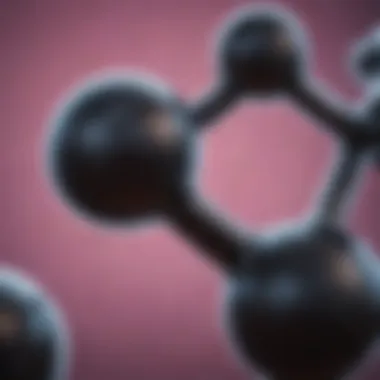Exploring Manganese Chloride Solution: Uses and Insights


Intro
Manganese chloride solution is gaining attention in multiple fields due to its varied properties and applications. It is a solution derived from manganese chloride, a chemical compound with significant implications in areas such as agriculture, electronics, and environmental science. Understanding its unique characteristics can help various professionals leverage its potential in innovative ways.
The chemical composition of manganese chloride, along with its preparation methods, creates opportunities for diverse applications. As industries continue to seek effective solutions for current challenges, the relevance of manganese chloride solutions becomes progressively more important.
In this exploration, we aim to cover the essential aspects of manganese chloride solution, providing insights into its uses and the considerations surrounding its application, including safety and environmental impacts.
Research Highlights
Key Findings
- Chemical Composition: Manganese chloride, when dissolved in water, forms a clear and slightly colored solution. It is essential for various biochemical processes in plants and animals.
- Applications in Agriculture: This solution plays a crucial role as a micronutrient, benefiting plant growth and enhancing crop productivity by addressing manganese deficiency in soils.
- Use in Electronics: Manganese chloride solution is used in the production of batteries and other electronic components due to its conductive properties.
- Role in Environmental Solutions: It serves as a treatment agent for wastewater, aiding in the removal of contaminants and heavy metals, thus promoting environmental safety.
Implications and Applications
- The application of manganese chloride solution in agriculture leads to higher yields and robust plants, which is crucial as the demand for food increases globally.
- In the electronics industry, its usage aids in the innovation of efficient energy storage solutions, addressing current limitations in battery technology.
- Environmental scientists find value in its capacity to detoxify environments, thereby fostering sustainable practices.
"Manganese chloride solution represents a pivotal intersection of agricultural, industrial, and environmental interests, supporting advancements across sectors."
Methodology Overview
Research Design
The investigation into manganese chloride solution involves a comprehensive review of existing literature and experimental studies. This dual approach allows researchers to assess both theoretical and practical aspects of the solution's utility.
Experimental Procedures
Experiments typically involve dissolving manganese chloride in controlled environments, followed by tests in agricultural and industrial applications. Specific protocols include:
- Preparing the manganese chloride solution at various concentrations.
- Conducting plant growth trials to determine efficacy as a micronutrient.
- Testing conductivity and performance in battery applications.
- Monitoring the solution's effectiveness in wastewater treatment scenarios.
Such methodologies ensure a thorough understanding of the manganese chloride solution's properties and its potential exploitations across different fields.
Intro to Manganese Chloride Solution
Manganese chloride solution serves as a vital component in various scientific and industrial applications. This compound displays unique chemical and physical properties that contribute significantly to several fields, from agriculture to electronics. Understanding manganese chloride solution is essential because it helps researchers and professionals optimize its use and ensure safety in handling it.
Chemical Composition
Manganese chloride normally appears in the form of a crystalline solid that can dissolve in water. The chemical formula is MnCl₂. Tis composition indicates that each molecule consists of one manganese atom and two chlorine atoms. The manganese in the compound is in the +2 oxidation state, making it important for various biochemical processes. This compound also exhibits hydrated forms, such as MnCl₂·4H₂O, which holds four water molecules. This hydration plays a role in its reactivity and solubility, impacting its applications in different settings, particularly in plant nutrition and industrial uses.
Physical Properties
The physical properties of manganese chloride solution play a significant role in its functionality. It tends to be a pale pink or light red crystalline solid when mixed with water. One primary characteristic is its high solubility; it can dissolve readily in aqueous solutions. This quality makes manganese chloride an effective source of manganese for agricultural soils, as it facilitates better uptake by plants. In terms of density, the solution varies according to its concentration, typically ranging from 1.75 g/cm³ for concentrated solutions. Furthermore, the melting point of manganese chloride in its anhydrous form is around 650 °C. These physical attributes reinforce its practical applications in diverse areas, highlighting its importance as an essential chemical in both scientific and industrial environments.
Synthesis of Manganese Chloride Solution
Understanding the synthesis of manganese chloride solution is crucial in numerous application contexts. This synthesis lays the groundwork for its diverse uses across various fields including agriculture, electronics, and biotechnology. Knowledge of the preparation methods can help optimize the product quality, ensuring that it meets the specific requirements for each application. The benefits are multi-faceted: higher purity levels lead to better performance in agricultural applications, while precise synthesis is essential for electronic components.


Methods of Preparation
Manganese chloride solution can be prepared through several methods, with differences based on intended use and desired concentration. A common method involves dissolving manganese oxide or manganese carbonate in hydrochloric acid.
- Reaction with Hydrochloric Acid: This method is straightforward and widely applied in laboratories. The main equation can be simplified as follows:
- Purification Steps: After obtaining the solution, further purification through crystallization may be necessary. This helps in removing impurities that could affect the quality of the final product.
- Concentration Adjustments: Depending on the application, the concentration of manganese chloride can be adjusted. Monitoring the temperature and pressure during the reaction helps achieve desirable concentrations.
Purity and Quality Control
Maintaining purity and quality of manganese chloride solution is essential due to its implications in various industries. Contaminants can alter the chemical behavior and performance of manganese chloride.
- Analytical Techniques: Various analytical methods are used to assess the purity. Techniques like atomic absorption spectroscopy and inductively coupled plasma mass spectrometry are effective.
- Establishing Standards:
Companies often adhere to strict standards for purity. These standards ensure that the manganese chloride meets the necessary criteria for agricultural or industrial applications. - Batch Testing: Implementing quality control during production involves batch testing. Each batch should be analyzed for consistency and effectiveness in its intended use.
It is vital to ensure that manganese chloride solutions remain free of contaminants to avoid detrimental effects in their applications, whether in soil or manufacturing.
Applications in Agriculture
Manganese chloride solution plays a significant role in the agricultural sector. Its applications enhance both soil quality and livestock nutrition. Understanding these applications can help optimize farming practices and improve yields.
Nutrient Supply in Soil
Manganese is an essential micronutrient for plants. It plays a crucial role in photosynthesis, chlorophyll synthesis, and enzyme activation. A manganese deficiency can lead to stunted growth, chlorosis, and reduced crop quality.
Manganese chloride can be applied directly to the soil. This ensures that the nutrient is readily available for plant uptake. Here are some specific benefits:
- Enhances Soil Fertility: It improves the overall fertility of the soil. The solution enriches the nutrient profile, providing vital minerals needed for plant growth.
- Corrects Deficiencies: In areas where soil lacks manganese, its application can help correct deficiencies. This is particularly important in acid soils where manganese is often unavailable.
- Boosts Crop Yield: Adequate manganese levels can lead to increased crop yields and better quality produce. Farmers often observe a positive change in yield after applying manganese chloride.
"Most crops require manganese. Its deficiency can have detrimental effects on both growth and yield."
Animal Feed Supplementation
Manganese chloride is also used as a dietary supplement for livestock. Animals require manganese for several physiological functions, including bone development and reproductive health. Supplementation can enhance the overall health of livestock, ensuring optimal growth and productivity.
- Bone Development: Manganese is critical for the formation of cartilage and bone. Proper levels in animal feed can prevent skeletal abnormalities.
- Reproductive Health: Adequate manganese in the diet supports reproductive functions. It can help improve fertility rates in breeding animals.
- Improved Growth Rates: Livestock with sufficient manganese intake show better growth rates. This results in higher productivity for farmers.
Industrial Uses of Manganese Chloride Solution
Manganese chloride solution plays a significant role in various industries. Its unique properties allow for effective applications that are essential for production processes and product quality. Understanding these uses provides insight into its importance in both economic and technological contexts. It offers solutions that enhance efficiency and improve end products across different sectors.
Electronics Manufacturing
In the electronics industry, manganese chloride solution is a vital component in the production of various electronic materials. One of its primary uses includes serving as an electrolyte in batteries. This compound facilitates efficient conduction of electricity, which is critical for battery performance. As energy storage solutions gain traction, the demand for manganese chloride in battery manufacturing continues to rise. The solution also finds application in coating processes for printed circuit boards, enhancing the quality and reliability of electronic devices.
Moreover, manganese chloride aids in producing high-purity semiconductor materials. Its application in semiconductors is crucial, as the presence of impurities can drastically affect the electrical properties of the materials involved. This has spurred research into developing cleaner processes that utilize manganese chloride effectively.
Textile Industry Applications
The textile industry also benefits from manganese chloride solution in multiple ways. One of the primary applications is in dyeing processes. Manganese chloride serves as a mordant, helping fix dyes to fabrics. This is particularly important in achieving vibrant colors and improving the wash fastness of dyed products. As a result, textile manufacturers can offer high-quality products that meet market standards.
Additionally, manganese chloride is involved in the production of various textile chemicals. It has potential as a catalyst in producing certain synthetic fibers. This can lead to more sustainable production methods and minimize environmental footprint. The textile industry is under pressure to adopt greener practices, making manganese chloride a relevant and practical choice.
Ultimately, the industrial applications of manganese chloride solution extend beyond mere functionality. It presents substantial benefits, including improved product quality and potential environmental advantages. Manufacturers in both electronics and textiles increasingly recognize its value, which is reflected in ongoing research and development efforts.


Health and Safety Considerations
Health and safety considerations are critical when working with manganese chloride solution. Understanding the potential hazards associated with its use, handling, and storage can significantly reduce risks to health and the environment. Precautionary measures are essential in both laboratory and industrial settings to ensure safety for workers and to mitigate any potential negative impacts on the surrounding community and ecosystem.
Hazard Identification
Identifying hazards linked to manganese chloride is the first step in ensuring safety. Manganese chloride can pose several risks:
- It is potentially harmful if ingested, inhaled, or absorbed through the skin.
- Exposure can cause respiratory issues, skin and eye irritation, and gastrointestinal distress.
- Long-term exposure may lead to more serious health conditions, including neurotoxic effects.
- In concentrated forms, it can be corrosive and pose a risk to users, especially in industrial settings.
Recognizing these hazards is essential, especially for individuals working in sectors that regularly deal with this chemical. Proper labeling and Material Safety Data Sheets (MSDS) can inform users about potential risks and safety measures. Furthermore, it is recommended to conduct periodic risk assessments to ensure that any new applications or processes involving manganese chloride are evaluated for safety.
"Proactive hazard identification allows for the creation of a safer work environment, which is beneficial for both workers and employers."
Handling and Storage Guidelines
Proper handling and storage of manganese chloride solution minimize health risks and ensure safety during laboratory and industrial operations. The following guidelines are recommended:
- Personal Protective Equipment (PPE): Wear protective clothing, gloves, and safety goggles when handling the solution to minimize direct contact and exposure.
- Ventilation: Ensure adequate ventilation in workspaces. Fume hoods may be necessary for laboratory environments to prevent inhalation of aerosolized particles.
- Storage Practices:
- Emergency Procedures: Develop and communicate emergency procedures in case of spills or exposure. This includes having first-aid kits accessible and training staff on how to respond effectively.
- Waste Disposal: Follow guidelines for the disposal of hazardous waste as per local regulations to prevent environmental contamination.
- Store manganese chloride in a cool, dry place, away from incompatible substances such as strong oxidizers.
- Use appropriate containers that are resistant to corrosion and clearly labeled with hazard warnings.
By adhering to these guidelines, industries can significantly reduce the risk associated with the handling and storage of manganese chloride solution, ensuring a safer work environment for all.
Environmental Impact of Manganese Chloride Solution
The environmental impact of manganese chloride solution is a critical aspect of its applications and implications. Throughout its use in various industries, it is essential to consider its effects on ecosystems and public health. Understanding this impact ensures that risks are managed effectively, especially as the demand for manganese chloride continues to rise. Awareness of the environmental implications is needed not just for compliance but also for sustainable practices.
Toxicity Considerations
Manganese chloride can exhibit toxic properties depending on its concentration and exposure routes. Some studies indicate that high levels of manganese can lead to adverse health effects in both humans and wildlife. Prolonged exposure may cause neurotoxicity, which raises concerns for populations in close proximity to manganese chloride production facilities or areas where the solution is heavily used.
Research has shown the potential for accumulation in the food chain, which can further exacerbate these risks. For instance, aquatic life may absorb manganese chloride from contaminated water, leading to increased toxicity levels in fish and other organisms.
Therefore, it is vital to monitor manganese chloride levels in various environments, particularly those impacted by industrial discharge.
Regulatory Framework
There is a regulatory framework in place to govern the use and disposal of manganese chloride solution. This framework varies across regions but generally focuses on limit values for manganese concentrations in water and soil. The US Environmental Protection Agency (EPA) and other similar bodies provide guidelines for safe handling and usage.
- Key regulations include:
- Maximum allowable concentration levels
- Environmental impact assessments for new facilities
- Regular monitoring of emissions and waste disposal practices
Adhering to these regulations is crucial not only for environmental protection but also for public safety. As research gains momentum toward understanding the broader implications of manganese chloride, regulatory bodies are likely to adapt these frameworks in response to new findings. Vigilance in following regulations will be key to mitigating potential hazards associated with manganese chloride use.
"Understanding the environmental aspects and regulatory protocols related to manganese chloride is paramount for sustainable utilization."
In summary, the environmental impact of manganese chloride solution highlights significant toxicity considerations and necessitates a robust regulatory framework. Those engaged in its production and use must prioritize safety and compliance measures to minimize negative effects on the environment.
Recent Research Developments
Recent research in manganese chloride solution has brought significant attention to its applications and implications across various fields. As industries and academia discover new avenues for utilizing manganese chloride, the importance of these developments cannot be understated. Understanding the innovations and emerging uses provides insight into how this chemical plays a crucial role in modern practices.
Innovations in Production Techniques


Innovations in production techniques for manganese chloride have been a focal point in recent studies. Traditional methods often involve high energy consumption and complex processes. The push for more sustainable and economically viable methods has led researchers to explore alternative synthesis routes.
Notable advancements include:
- Green chemistry approaches: By employing environmentally friendly chemicals and processes, newer methods reduce waste and energy use.
- Microbial synthesis: Utilizing microorganisms to produce manganese chloride presents a more sustainable technique while also enhancing product yield.
- Improved purification techniques: Recent findings suggest that novel filtration processes can enhance purity and reduce impurities effectively.
By optimizing these production techniques, industries can not only cut costs but also align with global sustainability goals. This makes manganese chloride an attractive option in various applications, from agricultural uses to industrial developments.
Emerging Uses in Biotechnology
The field of biotechnology has begun to recognize the potential of manganese chloride solution in several innovative applications. Researchers are investigating how this compound can contribute to advances in medical and environmental biotechnology.
Some emerging uses include:
- Enzyme co-factors: Manganese is essential in metabolic processes. Studies are focusing on using manganese chloride as a co-factor in enzyme reactions for biotechnological applications.
- Gene editing technologies: Recent research indicates potential roles for manganese chloride in enhancing CRISPR-Cas9 technology, crucial for gene editing.
- Antioxidant properties: The compound's ability to function as an antioxidant is being researched for therapeutic applications in cellular health.
These developments may pave the way for groundbreaking applications in medicine and environmental cleanup efforts, showcasing manganese chloride's versatility and importance.
The advancements in manganese chloride solution research underscore its vital role in both current and future scientific landscapes.
Future Perspectives
The examination of future perspectives regarding manganese chloride solution is essential for understanding its evolving role in various sectors. The significance of this topic is underscored by the increasing interest in sustainable practices and innovative applications across industries. Manganese chloride solution, as a chemical compound, demonstrates a versatility that positions it uniquely for expansion in both research and practical application.
Market Trends and Demands
With a growing awareness of environmental sustainability and the need for efficient agricultural practices, there is an evident upward trend in the demand for manganese chloride solution. Industries such as agriculture and electronics are contributing significantly to this demand. The following points detail important trends:
- Agricultural Expansion: As countries seek to improve crop yields, manganese chloride is increasingly seen as a necessary nutrient in fertilizers. This has raised its demand, particularly in regions striving for greater food security.
- Adoption in Electronics: The role of manganese in the electronics sector, particularly in battery production, is on the rise. Innovations in battery technology, including the integration of manganese chloride, signify a shift towards more sustainable energy solutions.
- Bioscience Applications: Manganese chloride's emerging presence in biotechnology, particularly as a component in certain enzyme reactions, highlights a shift towards multifunctional chemical applications.
These trends indicate that the market is evolving, and manganese chloride solution is at the forefront of several growing industries. As these demands continue to flourish, suppliers and researchers will need to adapt to the changing landscape to meet expectations.
Potential Research Areas
Research surrounding manganese chloride solution is poised for significant advancement. Several areas merit attention, which could lead to enhanced applications and improved formulations. Consider the following potential research areas:
- Nanotechnology: Investigating the role of manganese chloride in nanomaterials could yield breakthroughs in various applications, from electronics to medicine. The unique properties at the nanoscale may enhance the functionality and efficacy of this compound.
- Healthy Agriculture Practices: Exploring the effects of manganese chloride on soil health and crop resilience could lead to innovative farming solutions. Understanding its influence on different soil types and crops is vital for maximizing nutritional benefits.
- Ecological Impact Studies: Comprehensive studies examining the environmental impact of manganese chloride solution, particularly concerning its toxicity and regulatory compliance, are necessary. This research could help formulate guidelines to mitigate negative effects while promoting its safe use in various applications.
Focusing on these areas can yield valuable insights, guiding future applications of manganese chloride and addressing contemporary challenges in agriculture, industry, and the environment. These prospects are crucial for establishing a scientifically grounded approach for ongoing utilization and development.
The End
The finale of our exploration into manganese chloride solution highlights its encompassing nature and multifaceted applications across diverse fields. Through careful scrutiny of its chemical composition, synthesis, and uses, we illuminate the significance of manganese chloride in agricultural practices, electronics, and contemporary health contexts.
Summarization of Key Findings
In summary, manganese chloride solution serves crucial roles, particularly:
- Agricultural Development: It acts as a vital nutrient source aiding in crop yields, as well as a significant supplement in animal feeds.
- Industrial Applications: The solution is integral in electronics manufacturing and textile processes, showcasing its versatility.
- Health Considerations: Recognizing its safety concerns and environmental impacts asserts a need for proper handling guidelines.
- Research Advancements: The ongoing innovations in its production methods and biotechnological applications indicate a growing relevance.
"Manganese chloride is not just an ordinary chemical; its implications span numerous sectors, proving essential to advancements in technology and sustainable practices."
Implications for Future Research
Future studies can aim at several directions regarding manganese chloride solution. Considerations include:
- Enhanced Production Techniques: Developing more sustainable and cost-effective methods can improve availability and lower environmental footprints.
- Broader Applications: Investigating the potential uses in biotechnology, such as bioremediation and drug delivery systems, could unveil significant benefits.
- Toxicity Studies: Further evaluations on the long-term exposure effects in various contexts can lead to improved regulations and safer handling protocols.
- Market Analysis: Understanding market dynamics can illuminate trends that may redefine manganese chloride's role in both agriculture and industry.



